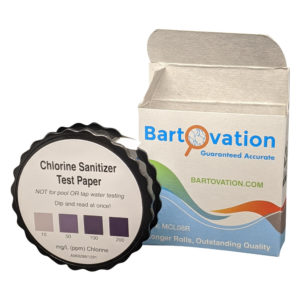Description
This Chlorine Test Paper provides a simple, reliable, and economical means to measure the concentration of free available chlorine in sanitizing solutions. The Chlorine Test Paper measures total available chlorine from 0-200ppm, and give results in just seconds. Total available chlorine is the sum of free available chlorine and the combined available chlorine. Our chlorine test paper is most often used to test the strength of solutions used to sanitize surfaces, for example, in the restaurant industry. In these types of applications, bleach is usually used to generate the available chlorine.
When using bleach as a cleaner, it must be diluted before use, and it will work best in the pH range of 5-7.
How to test for chlorine:
- Use dry fingers to remove a chlorine test paper strip from the vial.
- Dip the test strip into the solution to be tested, and do not agitate.
- Remove and compare to the color chart immediately.
NOTE: The strip will darken over time, so it is best to compare to the color chart as directed. In addition, if two strips are stuck together, the color will be darker. Lastly, if you lay the strip against the vial when comparing to the color chart, it will also darken the color. The color chart was created by holding a strip in the air next to the vial.
NOTE: If you believe that the solution contains chlorine, but the test the strip is white after dipping, you may be seeing what is referred to as the “bleaching out effect.” At high concentrations of bleach, the available chlorine will overwhelm the indicators used in the strips. If this happens, instead of developing a purple color the strip will very quickly turn to white. The best indicator of this effect is the presence of a thin blue line on the strip separating the wet portion from the dry portion of the strip.
Are you unsure if this test strip is best for your needs? You can review our handy restaurant sanitizer guide!

![Restaurant Sanitizer Chlorine Test Paper, <span class="bldppm">10-200 ppm</span> [Vial of 100 Paper Strips]](https://bartovation.com/wp-content/uploads/2020/03/712KN4zLhfL._SL1500_.jpg)
![Restaurant Sanitizer Chlorine Test Paper, <span class="bldppm">10-200 ppm</span> [Vial of 100 Paper Strips] - Image 2](https://bartovation.com/wp-content/uploads/2020/03/PCL08V100-PHOTO-3-LABEL.jpg)
![Restaurant Sanitizer Chlorine Test Paper, <span class="bldppm">10-200 ppm</span> [Vial of 100 Paper Strips] - Image 3](https://bartovation.com/wp-content/uploads/2020/03/Screen-Shot-2020-07-28-at-14.55.33.png)

![Restaurant Chlorine Sanitizer Plastic Test Strips, <span class="bldppm">0-200 ppm</span> [Moisture Wicking Vial of 100 Strips]](https://bartovation.com/wp-content/uploads/2020/03/PCL03V100-MAIN-300x300.jpg)
![Hydrogen Peroxide H2O2 Test Strips, Low Level, <span class="bldppm">0-100 ppm</span> [Vial of 100 Strips]](https://bartovation.com/wp-content/uploads/2020/03/PER-100-Main-1-300x300.png)
![Restaurant Chlorine Sanitizer Plastic Test Strips, <span class="bldppm">0-300 ppm</span> [Moisture Wicking Vial of 100 Strips]](https://bartovation.com/wp-content/uploads/2020/03/IMG_20191114_221309-1-300x300.jpg)
![Chlorine Low Range Test Strips, <span class="bldppm">0-5 ppm</span> [Vial of 50 Strips]](https://bartovation.com/wp-content/uploads/2025/03/PCL01V50-300x300.jpg)
![Extra High-Level Chlorine Test Strips, <span class="bldppm">0-10,000 ppm</span> [Vial of 100 Strips]](https://bartovation.com/wp-content/uploads/2020/03/CHL-10000-Main-1-300x300.png)